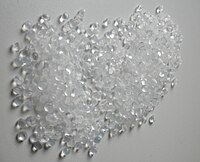
Photo from wikipedia
Abstract A large amount of waste salts (WS) produced during the production of pesticides has posed a great threat to enterprise production and human health. In the study, the regularity… Click to show full abstract
Abstract A large amount of waste salts (WS) produced during the production of pesticides has posed a great threat to enterprise production and human health. In the study, the regularity and efficiency of low-medium temperature pretreatment of pesticide WS were studied to provide help for the subsequent treatment and recycling of the WS. Eight kinds of WS originating from herbicides, insecticides, and bactericides were studied by thermogravimetric (TG) analyses and tubular furnace simulation experiments. The TG and kinetic results showed that the pretreatment temperatures ranged from 350 °C to 700 °C. The optimal disposal temperature varied for different WS, and oxygen could facilitate the pretreatment of WS. Tubular furnace simulation experiments indicated that the effect of pretreatment depends on the organic toxic pollutants (OTPs) components of the samples rather than the type of pesticide. Dicamba WS had the lowest removal rate of OTPs (58.23%), while triadimefon WS had the highest rate (99.74%). The mean rate of OTPs removal from WS was 80%. The results confirmed that low-medium temperature pretreatment can effectively eliminate most of OTPs in WS and reduce the burden of subsequent management and disposal. This technique can be useful for large-scale waste management in the pesticide industry.
Journal Title: Journal of Cleaner Production
Year Published: 2021
Link to full text (if available)
Share on Social Media: Sign Up to like & get
recommendations!